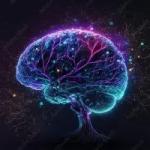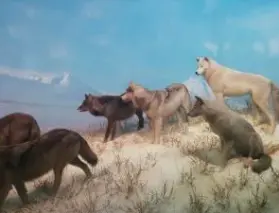 Every life inevitably ends in death; the creation of the new requires the demise of the old. Thus, in the process of Nature, for every one gained there is a minus one. Yet in Nature, this 1-1 does not equal zero, but equals the great abundance we see all around us. How do we account for this?
Every life inevitably ends in death; the creation of the new requires the demise of the old. Thus, in the process of Nature, for every one gained there is a minus one. Yet in Nature, this 1-1 does not equal zero, but equals the great abundance we see all around us. How do we account for this?
The simple explanation is that while the 1-1=0 of mathematics is a timeless truth, the 1-1 of Nature takes place in time. The great abundance is what Nature gains between the borrowing and repayment, the life lent through birth and repaid upon death.
That time should yield such abundance is not so easily explained. It is simple enough to say “this is how the laws of nature work.” But why the laws of nature work this way, why they lead to such complexity and abundance, that question does not yield to any simple explanation.
Cosmologist Lee Smolin, in his book The Life of the Cosmos, states:
We are far enough along that it now becomes possible to ask as a serious question: not What are the laws of nature? But, Why are the laws of nature as we find them to be, and not otherwise?
Smolin goes on to discuss this question in great detail, but those details are not important here. The bottom line is that he has to admit, we simply don’t know the answer. It’s a mystery.
Actually, the question of cosmic origins contains three nested mysteries. The first is the old metaphysical plum, why is there something rather than nothing? Of this, nothing can really be said.
The second is, given that there is something rather than nothing, how, in a universe given to inexorable entropy, did the disentropy of the early universe come about? In other words, if we think of the universe as a kind of old clock with a spring mechanism that constantly runs down, how did it get wound up in the first place?
And the third, the one Smolin addresses: given that the universe did begin in a state of disentropy, how is it that after 14 billion years there is not only the cold background radiation, but also all this novelty and complexity, such as the billions of galaxies that are still giving birth to new stars and solar systems. And, we can add, the continuing evolution in at least one of these solar systems of creatures capable of contemplating and questioning how this is done.
There appears to be a simple answer to all these questions: if the universe wasn’t such as it is, we wouldn’t be here to notice. That we are here to notice requires that the universe be as it is. This appears to be an answer, but it really explains nothing. It amounts to saying that the universe is as it is, because it is as it is. That’s a tautology, not an explanation.
Human’s love a good mystery, but only if it isn’t really a mystery, just a hard problem. A fundamental mystery, one where we not only don’t have the answer, but aren’t even sure how we would go about obtaining an answer, that kind of mystery is very disturbing. It causes cognitive dissonance. It’s humbling.
Scientists, when they speak at all of the mystery of ultimate origins, often suggest that while we don’t know now, with the progress of science we may well figure it out in the future. In other words, they suggest that the Great Mystery is only a really hard problem, not a fundamental mystery. Perhaps this is true, and some time in the future, there will be an answer. Who can say, the future is itself a mystery. There are good reasons, however, to question this. It is quite possible that the information we would need to solve this mystery exists too far away in time for us to have access any empirical access to it; or perhaps even that time, as we know it, arose out of the Great Mystery, so that the information we need doesn’t exist in our time at all.
Currently, the Big Bang Theory is the most widely accepted version of the beginning of the universe. One might ask, doesn’t the Big Bang Theory tell us about our ultimate beginning? As far as the three aspects of the Great Mystery listed above, the answer is no. There is nothing in that theory that really explains these. If the Big Bang is the absolute beginning, then the Big Bang is pure miracle, the ultimate pulling of a rabbit out of a hat. This is why cosmologists have put forth the idea of a Multiverse, of which this universe is but one small piece. The Multiverse idea provides hope that there might be a naturalistic answer to the question of ultimate origins. But how one would go about demonstrating that the Multiverse actually exists is also a mystery. As of right now, the idea of the Multiverse is a bit of metaphysics camouflaged as science.
“So what if there is a mystery?” one might ask, “what does any of this matter?” Well, what does anything matter? Perhaps it is wise not to bother with such questions. But I think anyone with a lively curiosity will inevitably bump up against the question of ultimate origins. Contemplating the mystery of these origins takes us to the farthest reaches of knowledge.
Many of us as children asked parents or teachers the question “where do I come from”? And if the answer was given that “you come from your parents,” we would ask “where do my parents come from?” And on and on. Inevitably this string of questions would lead to the answer, “it comes from God.” And if we asked, “where does God come from?” it was made clear that it was time for this string of questions to end.
Well that never satisfied me. When it comes to Nature, I’m still a child, still a beginner. My curiosity about Nature never seems to ebb, and that neither science nor religion provides an adequate answer to the question of ultimate origins fascinates me. The Great Mystery is the source and ultimate context of that great unfolding process that we call Nature. We are the offspring of that process.
The Great Mystery is the best answer we have to the question “from where do I come?”, even if it’s only a Cheshire Cat’s grin of an answer.
* * * * * *
In Vol. 19 of The North American Indians, Edward Curtis writes: “there is a tendency, both by observers and the Indians themselves, to translate Wakónda (Wákan-tanka) as ‘Great Spirit.’ Such a translation is not borne out by the primitive use of the word nor by Siouan thought. The translation should be ‘Great Mystery.’ Without putting it in words, Siouan philosophy says, ‘We know not what it is, but we do know that it is.’”
I would suggest that the world would be a better place if people everywhere, when speaking of “God,” “Allah,” “The Absolute,” “Tao” or whatever other words they might use to refer to that which is the ultimate source and context of existence, simply recognized and admitted that “We know not what it is, but we do know that it is.” And further, that those who claim to be atheist would admit that the great abundance of the world remains unexplained, remains a great mystery. We simply do not know what that mystery hides.
In his poem “The Second Coming,” the poet W. B. Yeats wrote: “the best lack all conviction, while the worst are filled with passionate intensity.” If Curtis’s interpretation is correct, the Siouan philosophy forms a wonderful middle ground between these extremes. It has great conviction that this ultimate source exists — it is not agnostic in the least — but it also recognizes that it is a mystery, it’s what we don’t know. There is no reason to get passionate about it.
Yet, people get very passionate about their religious beliefs and I wonder if this is not because the beliefs are actually so questionable. There is no reason for being passionate about something we know for a fact. And equally, there is no reason to get passionate about something we know to be a mystery. Facts are facts and a mystery is a mystery. Of the first we can speak, of the second we probably should remain silent.













